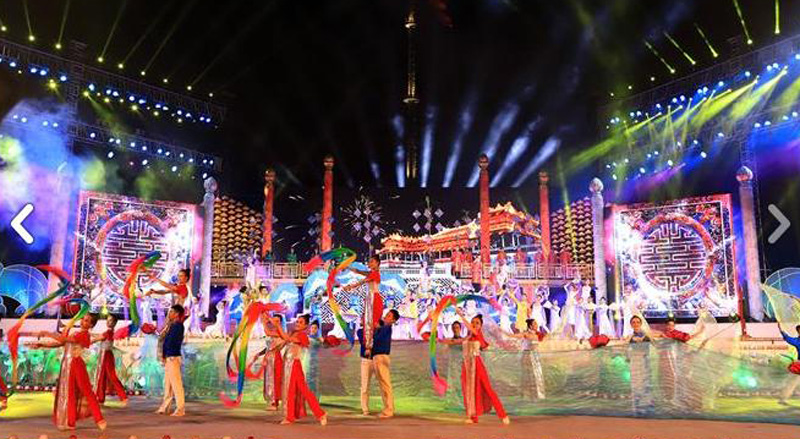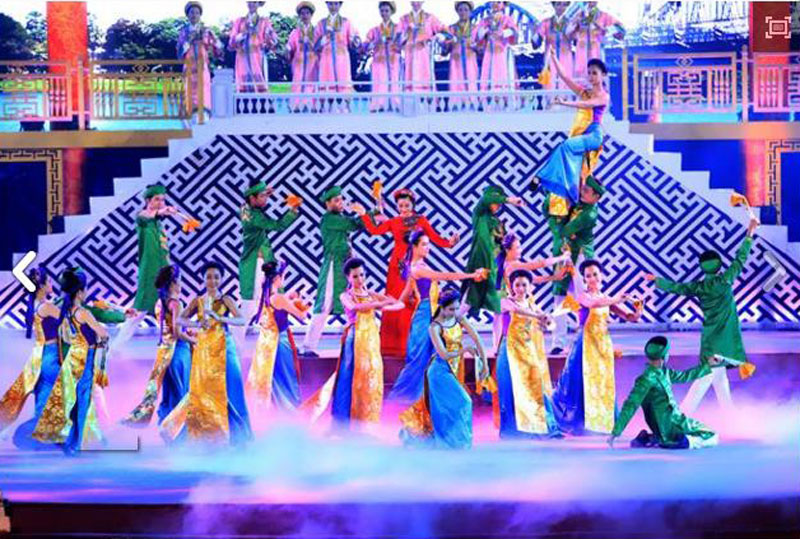
The Hue Festival 2018 came to an end on May 2, following a vibrant closing night featuring Hue’s royal court music performances and firework shows.
This year’s festival was held in the central province of Thua Thien-Hue from April 27 to May 2,
attracting thousands of visitors.

An performance at the closing night of Hue Festival 2018.
(Photo: VNA)
The 10th
edition of Hue Festival, an important event of the ancient imperial capital,
wrapped up after six days of exciting and impressive activities, said Nguyen
Dung, Vice Chairman of the provincial People’s Committee at the closing
ceremony.
The Hue
Festival 2018 offered stages for 786 performers representing 20 countries and
territories including Vietnam.
Audiences were provided chances to enjoy 72 stage shows as well as take part in
37 community activities held by local residents.
It aimed
to celebrate 712 years since the founding of Thuan Hoa - Phu Xuan, which is Hue today. The festival
was themed ‘Cultural Heritage with Integration and Development: Hue - One Destination,
Five World Heritages’.
The five
heritage statuses were awarded to the Complex of Hue Monuments, Hue royal court music, woodblocks, the imperial archives
of the Nguyen Dynasty and royal literature on Hue royal architecture.
"Van hien
kinh ky”, a highlight of the festival,was an art show which combined a
variety of elements: dance, chorus, animation, poem reciting and music. The
90-minute show featured all cultural values of Hue through heritage elements.
Meanwhile,
a show, titled "Am vong Song Huong” (Resonance of Perfume River), on April 29
involved hundreds of professional and amateur actors and actresses, depicting
the life cycle of people living on the rivers from their marriage, giving birth
and raising children to passing down their occupation from generation to
generation in a joint effort to preserve Hue cultural values.
The same
day, streets in the silent city of Hue
were bustling with performances by art troupes in a street parade. The art
troupes from countries and territories, including Japan,
the Republic of Korea,
Thailand, Mongolia, Belgium,
Poland and Slovakia,
brought their native colours to the streets. Audiences enjoyed their
performances, which demonstrated their circus skills, along with dance and
music, and displayed their costumes.
An "Ao
dai” show took place on May 1 evening, exhibiting exhibited collections of the
Vietnamese national long dress. The show, titled"The Heyday of Hue”, was
aimed at depicting"ao dai”in Hue
in different eras, with a focus on those worn during the imperial time under
the rule of the Nguyen Dynasty (1802-1945).
The
designers, hailing from different regions in the country, attempted to get
closer to Hue
by using symbolic patterns of the city on their designs, besides mimicking the
attires of royals and nobles.
Hue city
was the imperial capital of Vietnam
for hundreds of years. It is home to five UNESCO-recognised heritages, namely
the Hue ancient citadel relic complex – a World Cultural Heritage site; Nha
Nhac (Hue royal court music) - an intangible cultural heritage item; Nguyen
Dynasty’s wood blocks – a documentary heritage item; Nguyen Dynasty’s Chau ban
(royal administrative documents) – part of the Asia-Pacific Register of
UNESCO’s Memory of the World Programme; and literature on Hue royal
architecture - a documentary heritage.
Source: VNA
The clothing of women reflects the culture of the Muong, Thai, Tay, Dao, and Mong ethnic groups in the northern province of Hoa Binh.
Gongs hold a special place in the cultural and spiritual life of the Muong ethnic people in Hoa Binh province. More than musical instruments, they are an indispensable part of community rituals and collective memory, echoing through generations as a spiritual thread linking the past, present, and future.
Preserving and promoting the cultural values of the Muong ethnic group has become an urgent task in the current context, as many traditional values face the risk of fading away. This effort requires not only protecting the cultural identity but also eliminating outdated customs and developing a modern cultural lifestyle, contributing to sustainable values for the Muong community in Hoa Binh province.
The Muong ethnic culture, deeply rooted in Vietnam’s mountainous north, continues to be preserved and revitalised by dedicated individuals and communities determined to safeguard their ancestral identity.
The Muong group is one of the largest ethnic minorities in Vietnam, primarily found in Hoa Binh province. The Muong people in Hoa Binh boast a rich and diverse cultural treasure that reflects the unique identity of this ethnic group. Accounting for over 63% of the province's population, they have created and preserved numerous distinctive cultural values, contributing to their unique identity. Their cultural heritage is an invaluable asset, at the heart of their national identity, and represents a vibrant spiritual life that must be preserved and promoted in today’s modern world.
For generations, the ethnic communities of Hoa Binh province, particularly the Muong people, have preserved vibrant festivals deeply intertwined with the region’s geography, nature, and social traditions. These celebrations enrich Hoa Binh’s spiritual life and cultural identity, reflecting both folk beliefs and the intermingling of ethnic customs. Many of these festivals have endured the test of time, passed down through generations and continuing to thrive today. Among them, the Khai Ha (Going Down to the Field) festival stands out as one of the most significant events of the Muong ethnic group.



